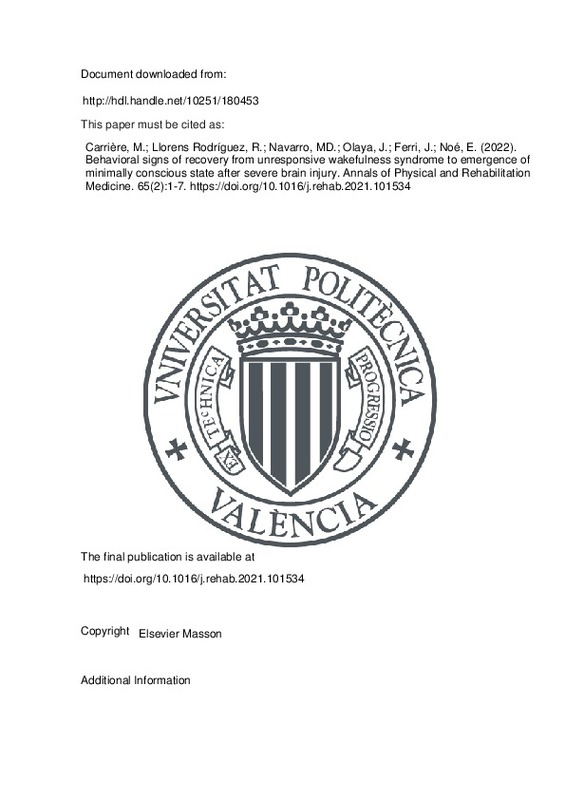JavaScript is disabled for your browser. Some features of this site may not work without it.
Buscar en RiuNet
Listar
Mi cuenta
Estadísticas
Ayuda RiuNet
Admin. UPV
Behavioral signs of recovery from unresponsive wakefulness syndrome to emergence of minimally conscious state after severe brain injury
Mostrar el registro sencillo del ítem
Ficheros en el ítem
| dc.contributor.author | Carrière, Manon
|
es_ES |
| dc.contributor.author | Llorens Rodríguez, Roberto
|
es_ES |
| dc.contributor.author | Navarro, María Dolores
|
es_ES |
| dc.contributor.author | Olaya, José
|
es_ES |
| dc.contributor.author | Ferri, Joan
|
es_ES |
| dc.contributor.author | Noé, Enrique
|
es_ES |
| dc.date.accessioned | 2022-02-02T19:01:54Z | |
| dc.date.available | 2022-02-02T19:01:54Z | |
| dc.date.issued | 2022-03 | es_ES |
| dc.identifier.issn | 1877-0657 | es_ES |
| dc.identifier.uri | http://hdl.handle.net/10251/180453 | |
| dc.description.abstract | [EN] Precise description of behavioral signs denoting transition from unresponsive wakefulness syndrome/vegetative state (UWS/VS) to minimally conscious state (MCS) or emergence from MCS after severe brain injury is crucial for prognostic purposes. A few studies have attempted this goal but involved either non-standardized instruments, limited temporal accuracy or samples, or focused on (sub)acute patients. The objective of this study was to describe the behavioral signs that led to a change of diagnosis, as well as the factors influencing this transition, in a large sample of patients with chronic disorders of consciousness after severe brain injury. In this retrospective cohort study, 185 patients in UWS/VS or MCS were assessed with the Coma Recovery Scale Revised (CRS-R) five times within the two weeks following their admission to a neurorehabilitation center and then weekly until emergence from MCS, discharge or death. Of these 185 patients, 33 patients in UWS/VS and 45 patients in MCS transitioned to another state. Transition to MCS was mostly denoted by one behavioral sign (72%), predominantly visual fixation (57%), followed by localization to noxious stimulation (27%), visual pursuit (21%) and object manipulation (12%), and could be predicted by etiology, time post-injury and age. Emergence from MCS was characterized by one sign in 64% of patients and by two signs (functional communication and objects use) in the remaining cases, and could be predicted by time post-injury and number of behavioral signs at admission. Clinicians should be therefore advised to pay particular attention to visual and motor subscales of the CRS-R to detect behavioral recovery. | es_ES |
| dc.description.sponsorship | This work was supported by the European Union's Horizon 2020 research and innovation programme under the Marie Sk¿odowska-Curie (Grant Agreement No. 778234) and by Conselleria de Educación, Investigación, Cultura y Deporte of Generalitat Valenciana (Project SEJI/2019/017) | es_ES |
| dc.language | Inglés | es_ES |
| dc.publisher | Elsevier Masson | es_ES |
| dc.relation.ispartof | Annals of Physical and Rehabilitation Medicine | es_ES |
| dc.rights | Reserva de todos los derechos | es_ES |
| dc.subject | Disorders of consciousness | es_ES |
| dc.subject | Vegetative state | es_ES |
| dc.subject | Unresponsive wakefulness syndrome | es_ES |
| dc.subject | Minimally conscious state | es_ES |
| dc.subject | Brain injury | es_ES |
| dc.subject | Coma recovery scale revised | es_ES |
| dc.subject.classification | TEORIA DE LA SEÑAL Y COMUNICACIONES | es_ES |
| dc.title | Behavioral signs of recovery from unresponsive wakefulness syndrome to emergence of minimally conscious state after severe brain injury | es_ES |
| dc.type | Artículo | es_ES |
| dc.identifier.doi | 10.1016/j.rehab.2021.101534 | es_ES |
| dc.relation.projectID | info:eu-repo/grantAgreement/EC/H2020/778234/EU/ | es_ES |
| dc.relation.projectID | info:eu-repo/grantAgreement/GENERALITAT VALENCIANA//SEJI%2F2019%2F017//ACTIVA: ALTERACIONES DE LA CONSCIENCIA: PROTOCOLO/ | es_ES |
| dc.rights.accessRights | Abierto | es_ES |
| dc.description.bibliographicCitation | Carrière, M.; Llorens Rodríguez, R.; Navarro, MD.; Olaya, J.; Ferri, J.; Noé, E. (2022). Behavioral signs of recovery from unresponsive wakefulness syndrome to emergence of minimally conscious state after severe brain injury. Annals of Physical and Rehabilitation Medicine. 65(2):1-7. https://doi.org/10.1016/j.rehab.2021.101534 | es_ES |
| dc.description.accrualMethod | S | es_ES |
| dc.relation.publisherversion | https://doi.org/10.1016/j.rehab.2021.101534 | es_ES |
| dc.description.upvformatpinicio | 1 | es_ES |
| dc.description.upvformatpfin | 7 | es_ES |
| dc.type.version | info:eu-repo/semantics/publishedVersion | es_ES |
| dc.description.volume | 65 | es_ES |
| dc.description.issue | 2 | es_ES |
| dc.identifier.pmid | 33933691 | es_ES |
| dc.relation.pasarela | S\452567 | es_ES |
| dc.contributor.funder | European Commission | es_ES |
| dc.contributor.funder | GENERALITAT VALENCIANA | es_ES |







![[Cerrado]](/themes/UPV/images/candado.png)

